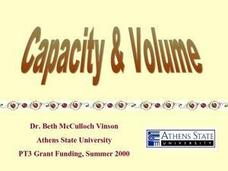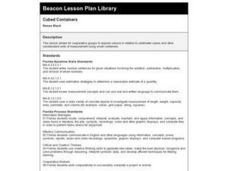Curated OER
Using Your Marbles - Volume Measurement and Reporting
Demonstrate how to measure the volume of liquids and solids immersed in liquid to your class. They observe a teacher-led demonstration, and in small groups construct a data table that demonstrates how many marbles were used and the...
Curated OER
Geometry and Measurement
Young geometers explore relationships between units of measure and objects. Three activities provide varied opportunities to practice. Learners calculate the volume of two cylinders made by rolling a piece of paper vertically and...
Curated OER
Capacity & Volume
Looking for a well-done presentation on capacity and volume? Then this presentation is for you! Capacity and volume are commonly mistaken for each other by young mathematicians. Of course, one is a measurement of how much a container...
Curated OER
Cylinder: Student Worksheet
Pairs of geometry whizzes work together to determine which of three differently shaped cylinders will have the greatest volume. Pupils cut out the three rectangles embedded in the plan, and tape them together to form a cylinder. From...
Curated OER
Cubed Containers
Learners explore volume in relation to centimeter cubes and other nonstandard units of measurement using small containers. They will use hands-on materials to practice this concept. You will need small objects and containers to set this up.
Curated OER
Cylinders and Scale
Students review what a cylinder is and how a cylinder is measured. They build a variety of cylinders with different heights and radii. They compare the surface area and volume of each cylinder and discuss anything that surprises them...
Curated OER
Popcorn Math
Everyone loves popcorn! Use this treat to teach math concepts including place value, estimating, graphing, and volume. Eight possible activities are included, and they can be modified to fit all grade levels.
Curated OER
Density - An Intrinsic Property
Learners discover the property of density while participating in a lab exercise. In this scientific measuring lesson, pupils utilize a scale to measure the density of different metal materials. They document their work and present their...
Curated OER
Size Them Up
Young scholars arrange containers by their capacity. For this volume lesson, students place containers in order by increasing capacity. Young scholars discuss how the tallest container doesn't necessarily hold the largest amount.
Curated OER
Liquids of Different Densities
Students compare the densities of different liquids. For this liquids lesson plan, students compare color, viscosity, weight, volume, and graph their findings.
Cornell University
Buoyancy
Swimmers know to float by turning their bodies horizontally rather than vertically, but why does that make a difference? In an interesting lesson, scholars explore buoyancy and the properties of air and water. They test cups to see which...
Curated OER
As a Matter of Fact!
Students explore matter. They use a formula to measure the volume of matter.
Curated OER
The Three States of Matter
Students explore the three states of matter. In this physics lesson plan, students are shown examples of solids, liquids, and gases. Students make cookies and identify the three states of matter during the baking process.
Curated OER
Math - "Solid Shapes" - Comparing 3-D Objects
In this geometry activity, students learn about 3-D objects and how to describe them. They then answer 10 questions using the information they learned. The answers are on the last page.
Curated OER
The Egg and I
Students collect as much information as possible about their egg and record the information in a systematic way. They prepare a description of the egg your team was given that enable you to distinguish your egg from everyone else's egg.
















